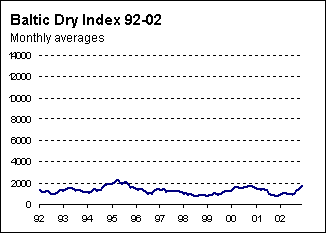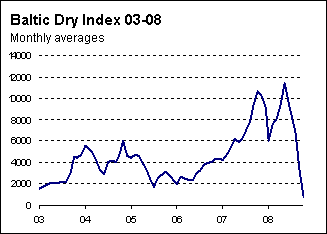The collapse of the Baltic Dry Index: What does it mean?
Since May this year, the Baltic Dry Index has collapsed (falling by 93%) – a movement that may be of concern for a small trading nation like New Zealand.
The Baltic Dry Index (BDI) is effectively an index of shipping costs for 26 of the main "dry commodity" shipping routes. Asa result, movements in the index give us some idea about how the cost of international shipping is changing.
However, over recent years the index has also been used as an indicator of the outlook for commodity prices. This interpretation of the index is something we discussed in detail back in March .
The reason behind this use of the index is as follows: as demand for commodities increases (which in turn increases commodity prices) it puts upward pressure on the limited number of shipping vessels – increasing the rates that shipping companies can charge. As a result, the recent decline in the index appears to indicate that demand for commodities has fallen sharply – and as a result current and future commodity prices may be a lot lower. Given New Zealand’s role as a commodity exporting nation, this implication is concerning.
Even so, it is important to take into consideration why the Baltic Dry Index has fallen before moving to an Armageddon type conclusion about the outlook for New Zealand commodity prices. The decline in the index is solely the result of the "capacity constraint" on shipping loosening – implying that we need to know why this has happened before we can make any conclusion about commodity prices.
BDI and shipping volumes – prior to the big run up and following
In order to get some perspective on movements in the Baltic Dry Index, it is important to look at the primary drivers of the index prior to the recent five-year "run-up" in value. Over the period from 1992 to 2002 the index was remarkably stable – even though trade volumes were just as variable as in recent history.

Graph 1
The two primary drivers of shipping costs are petrol prices and movements in international trade. Analysing the data indicates that the impact of these factors on shipping costs was relatively mild over this period.
Fundamentally, over this period international trade was not "capacity constrained" – there were plenty of shipping vessels that were all very similar. These vessels competed strongly for clients – implying that any change in international trade volumes did not lead to a marked change in shipping costs.
However, recent history is very different, as Graph 2 shows.

Graph 2
The run up in the BDI over the past five years is strongly the result of rising world trade volumes. Over this time the availability of trading vessels hit a wall, and exporters that wanted to ship products were forced to bid up the price of shipping in order to get hold of a carrier.
In other words, as the price of commodities increased the shipping vessel owners gained part of this windfall through the lift in the price of shipping.
What does this tell us about now?
The collapse in the BDI solely tells us that the capacity constraint has loosened – and at current trade volumes may not even be an issue anymore.
Given that we know this decline is the result of a loosening in this capacity constraint we have to ask, how has it loosened?
There are two possibilities:
- Demand for commodities has fallen markedly enough,
- The supply of shipping vessels has increased,
- Credit issues.
Now, it is likely that each of these factors have been significant in the current environment. Slowing global demand has seen demand for commodities fall – a factor that would have reduced demand for shipping vessels.
However, it is also the case that, in recent years, shipping companies have been investing in new shipping vessels to take advantage of high fees. These vessels take a while to be built, however many were forecast to hit completion by early 2009. As a result, an increase in the number of shipping vessels may partly be behind the recent decline in the BDI.
Furthermore, shipping is a high "fixed cost" industry that relies strongly on being able to run up debt to maintain cash-flow when demand is low. Recent credit market events have made it increasingly difficult for shipping companies to borrow – forcing them to accept lower payments for shipping in order to receive the payment in cash.
It is not clear which of these factors has dominated, but it is important to note that if the BDI has declined because of an increase in the supply of vessels, then the decline does not indicate that commodity prices will fall as markedly. As a result, we have to be careful when using the decline in shipping costs as evidence of falling international demand for New Zealand products.








